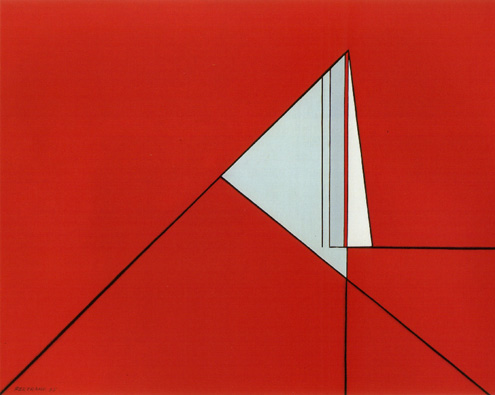Composition
rouge
(Red composition)

1955, oil painting on canvas, 65 x 81 cm
Coll. Museum L, Louvain-la-Neuve (Serge Goyens de Heusch donation)
N ° inv. 697
There was a time when Bertrand momentarily abandoned the subtle interplay between figuration and abstraction in order to produce works which were not any more based on what he saw - a landscape or an architecture. The artist thus composed his paintings just like an abstract painter would do, by inventing a combination of lines, shapes and planes drawn from the geometric shapes contained in his creative imagination.
As early as 1947, Gaston Bertrand was clearly attracted, just like some other fellow members of the Young Belgian Painting, to non-figurative art forms. Abstraction was at the time quite new in Belgium and was starting to emerge in the intellectual circles of the Paris avant-garde. Just like Louis Van Lint and Marc Mendelson, but in a more radical way given his taste for architecture, Bertrand evolved from a subjective vision, broadly shared among the group, towards purely abstract shapes. He was supported by Robert Delevoy, who always encouraged artistic researches within the Young Belgian Painting group.
Gaston Bertrand was more than ever convinced by the pictorial power of geometry and he undertook an in-depth study of this mathematical discipline from 1953 to 1957. As a passionate self-taught person, Bertrand read a number of specialized books with the same conscientiousness that he always demonstrated when exploring his fields of interest – art history, musical harmony or financial investments. He began to copy graphs, theorems and texts and then to speculate about various theories. The title of his works are, for instance, Organisation de la surface or Harmonie d’espacement. These works are perfect examples of minimalism and reflect Bertrand’s typical rigour, elegance and sensitiveness.